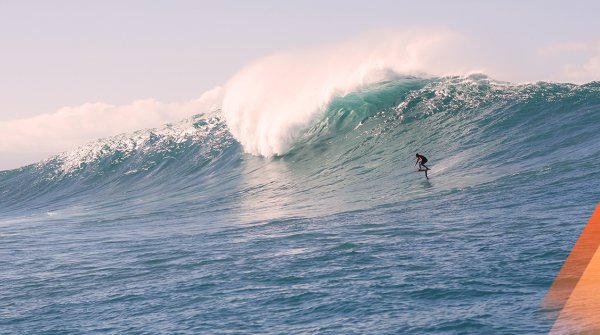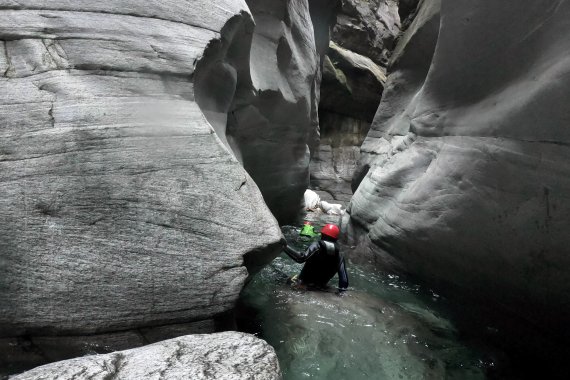
Have you every wonderes what canyoning actually is? Being out and about in the mountains is always an experience. Once infected with the outdoor virus, many enthusiasts push themselves to try other sports besides hiking. They strive to leave the familiar paths, challenge themselves and go where perhaps not so many others have gone before them. Especially in summer, when it's hot and you prefer to combine a visit to the mountains with a stay in and around the water and be active at the same time, it's a good idea to try out canyoning. Where you can try out the sport and what you need to know as a beginner when you venture into the gorge: ISPO.com tells you.
The Grand Canyon is probably the most famous canyon in the world and most people know it. Because canyon means exactly that. The term canyoning comes from the English word for gorge. Alternatively, the sport is also known as canyoneering. But what exactly is meant by this? Canyoning describes walking through a gorge from top to bottom. You enter the gorge at a certain point and then follow the course of the water. Sometimes on dry land, sometimes in cold water.
So it's actually about hiking? You could say partly, or if, canyoning is rather gorge hiking in the extreme. Because it takes different techniques to make your way through the gorge, such as rappelling, jumping, sliding, swimming or drifting in the current of the river. Usually combined with a hike to the entrance, canyoning combines quite a few elements of different outdoor sports.
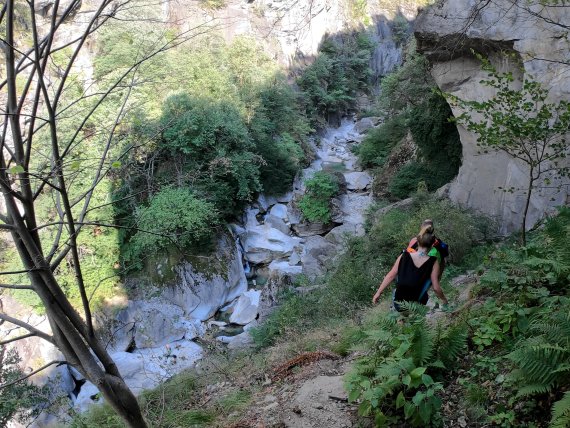
Simply entering a canyon alone is not a good idea if you want to give canyoning a try. Most tours are offered by commercial providers and accompanied by one or, depending on the size of the group and the difficulty of the gorge, several guides. This is also better, as there are a lot of things to consider when you are in the canyon. Water levels, different currents that are not visible at first sight, which are difficult to swim against and no signposted path through the gorge are all reasons for a guided tour.
As a beginner it is important to know that you are not forced to do anything on the tour. Even though most of the jumps to the entrance tend to be between one and three meters, you can often bypass or abseil them. The same applies to some abseils and often there is also the possibility to get out of the gorge on the way.
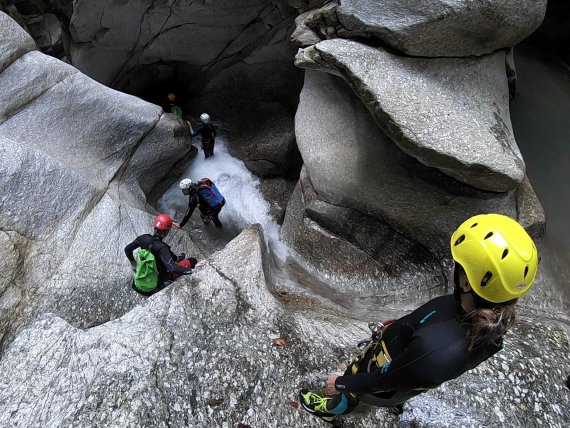
Canyoning also depends on the right technique. Many people look forward to the cliff jumps in particular and choose their tour specifically according to the height of the possible jumps. For beginners, however, it means to approach lower jumps for the first time.
Depending on the gorge and the level of the group, there may be higher canyoning jumps into pools and natural pools where it is even more important to dive in properly. To be on the safe side, it is important to follow the instructions of the guide, who will tell you where you can and cannot jump. Basically, all it usually takes is overcoming and a two-step run-up, or sometimes a big step into the void. While you slightly tense the middle of your body, your legs should remain slightly bent to cushion ground contact in the water if necessary. Otherwise, many jumps can be abseiled if you don't dare to jump, true to the motto, "everything can, nothing must". As a warning, however, it should be said that jumping from a height of 5 to 10 meters into a sometimes dark, sometimes glittering pool, however, draws a huge feeling of happiness and may be addictive.
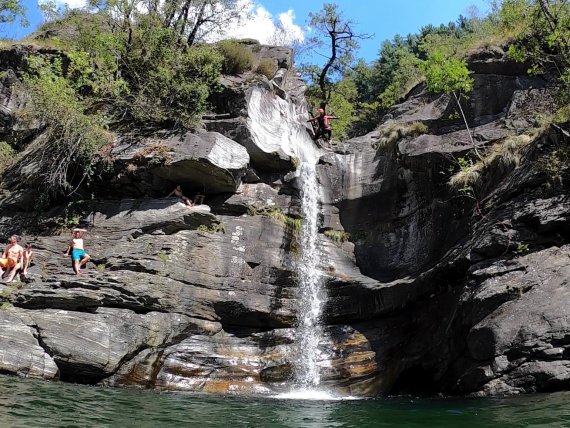
Wherever the water is not deep enough, or the jump would be too high, you are roped down. As a guest you don't have to worry about much: The guide sets up the stand and ropes down the guests from above. This is usually done passively, i.e. by the guide. You are clipped into the rope and are lowered and secured in a controlled manner, which makes abseiling more comparable to being lowered by a partner in sport climbing than to active alpine abseiling on high mountain tours. So you can just lean backwards over the edge, sit in the harness and enjoy the abseil. This thrill is probably more than enough for many, especially at the beginning.
As a third and especially fun element, sliding is also a part of canyoning. On natural water slides, you can also cover sections of the route, where you may pick up quite a bit of speed and, as in the artificial slide park, it's best to keep your arms close to your body.
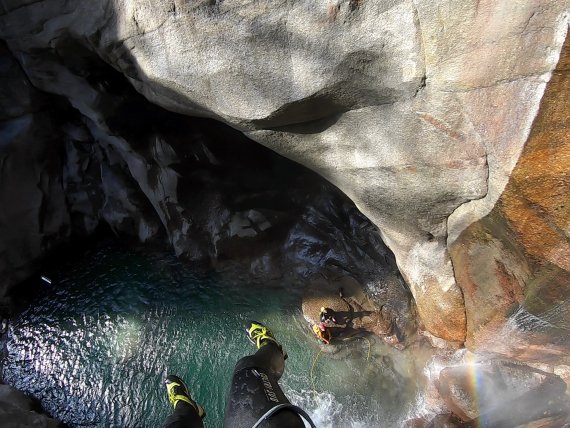
If you think that most canyoning accidents are caused by falls during rappelling or injuries during jumps, you are not quite right. Often injuries happen more during hiking or wading through flowing water, as wet and even mossy stones in shallow pools are more slippery than you think and therefore there is a risk of twisting your ankle. Sturdy shoes reduce the risk, as does the right equipment overall.
However, it can be really dangerous when canyoning without a professional guide. Previous knowledge of the Alps is only of limited help, different equipment is needed and special knowledge must be called up. However, with tour providers you are in good hands, because guides usually know the canyons of the offered tours and are well trained, because they have to renew their license regularly. As in the mountains in general, there is of course always a certain residual risk, for example due to the weather and as with any sport, injuries can also happen, even if one acts prudently.
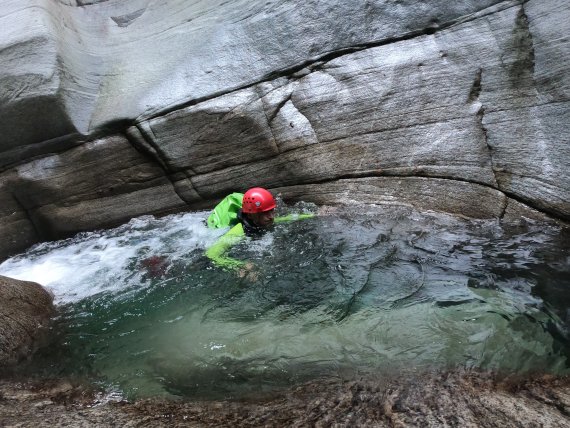
First of all, on guided tours the equipment is usually included. This consists of a thick neoprene suit with hood, which is roughened on the inside to provide as much warmth as possible. If you have ever put your feet into a mountain stream, you know that even in summer the water has rather low temperatures. And in the shady darkness of a gorge, even in sweltering heat, it is rather cool on the hiking trails during the ascent all day long. That's why neoprene socks also make sense, so that the feet also stay nice and warm. If you have to make size specifications for the rental in advance, you should in any case consider that these socks are thicker than normal ones and therefore the shoes are rather needed one size bigger.
Another part of the equipment is a helmet climbing helmet and a special harness for canyoning. This is used similar to a climbing harness for belaying, but is constructed a little differently. A bib made of solid plastic is connected to the wide band of the hip belt and the leg loops to provide additional protection when sliding. A self-belay is also attached to the harness, which basically consists of two loops, each with a carabiner fixed to prevent slipping.
You should also bring a bathing suit, a towel and a change of dry clothes. Most tour operators also send their guests packing lists or more detailed information on what to bring.
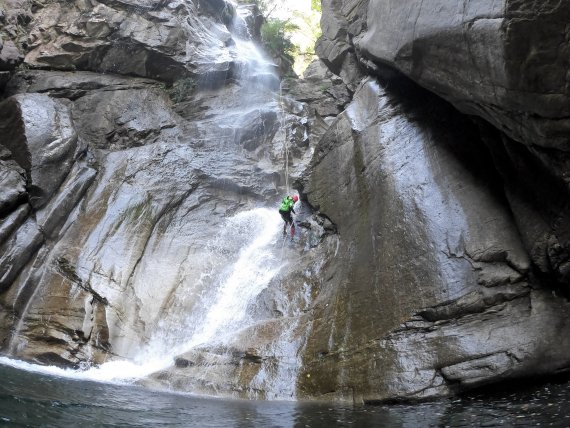
In the meantime, canyoning has spread as a trend sport and especially in the Alps there are different possibilities with beautiful, partly also fundamentally different gorges, for example in Switzerland, in the country of origin France, in Austria or also in Italy. Depending on the level, there is probably the right canyon for everyone, because the tours can differ greatly. While some offer high jumps, loud rushing waterfalls through which you can abseil, or long slides, there are also gorges that are suitable for families with smaller jumps and abseils. The same applies beyond Europe, because canyoning is also a special experience in New Zealand or the USA to experience nature on site.
So there are different possibilities to spend a day canyoning in the gorge. Depending on the length and difficulty of the tour, country and also provider, the prices can vary between 80 and 150 euros, sometimes even more.
Above all, it is important that you know how to assess yourself and your fitness level in advance and discuss with the tour guide what is suitable for your personal level, so that both the level of difficulty and the length of the tour are suitable and neither over nor under demanding. If the tour is well chosen and a basic fitness level is available, almost everyone will get their money's worth, whether it's just a challenging tour with house-high jumps and abseils for adrenaline junkies or more of a pleasure tour where you can let yourself drift in the water and relax while wandering through a fascinating world formed by water, where you can hardly close your mouth in amazement.
- ISPO awards
- Mountain sports
- Bike
- Design
- Retail
- Fitness
- Health
- ISPO Job Market
- ISPO Munich
- ISPO Shanghai
- Running
- Brands
- Sustainability
- Olympia
- OutDoor
- Promotion
- Sports Business
- ISPO Textrends
- Triathlon
- Water sports
- Winter sports
- eSports
- SportsTech
- OutDoor by ISPO
- Heroes
- Transformation
- Sport Fashion
- Urban Culture
- Challenges of a CEO
- Trade fairs
- Sports
- Find the Balance
- Product reviews
- Newsletter Exclusive Area
- Magazine

